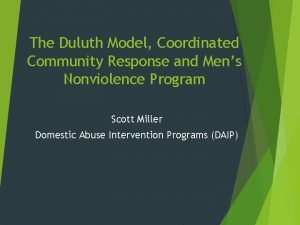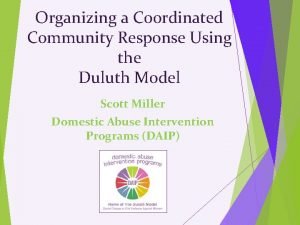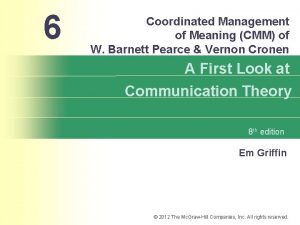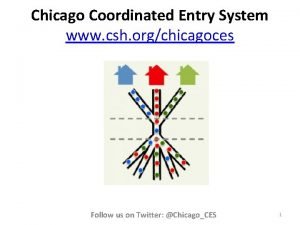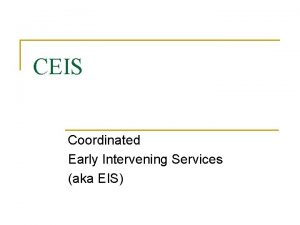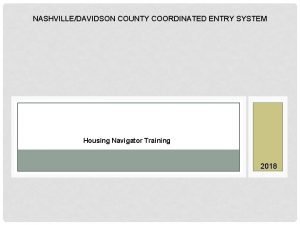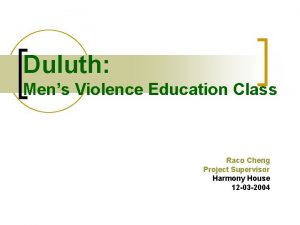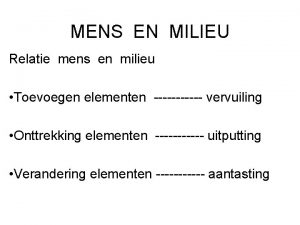The Duluth Model Coordinated Community Response and Mens































- Slides: 31

The Duluth Model, Coordinated Community Response and Men’s Nonviolence Program Scott Miller Domestic Abuse Intervention Programs (DAIP)

Battering An ongoing patterned use of intimidation, coercion, and violence as well as other tactics of control to establish and maintain a relationship of dominance over an intimate partner. When a person systematically utilizes various tactics of restricting an intimate partner’s autonomy and uses force or the threat of force as a coercive tactic. It is much more than a single act of violence or intimidation. Domestic Abuse Intervention Programs

Origins of the Duluth Model The Domestic Abuse Intervention Project which was a criminal justice reform effort began organizing in Duluth, MN in 1980. The DAIP responded to the problem of placing most of the responsibility for dealing with a batterer on the victim unless the officer witnessed the crime or there were serious injuries. The DAIP started with the notion that protecting victims is the obligation of the state. For this to be actualized meant that each criminal justice agency would have to change how they intervene when this crime was reported. Because there wasn’t a manual on how to do this, the early organizers drew on their experience working in other social change movements and their own common sense.

Early Strategies that Set the Foundation of the Duluth Model Building trusting relationships with criminal justice agencies was critical which entailed: Building a relationship with key decision makers. Observing and understanding the work of the agency. Reading policy, practice guides and forms that directed workers in the agency. Although police were the first agency to partner with the DAIP, all agencies would have to be coordinated in a complementary way. The DAIP organizers knew that no single agency could solve this social problem alone. All criminal justice agencies would have to be involved.

Early Organizing Leads to the First Policy Change: Mandatory Arrest In 1981, the Chief of Police agreed to a study: First third of patrol officers would be given a mandatory arrest policy in DV cases when probable cause could be determined and there were visible signs of injury. The second third of officers followed the existing policy which gave them complete discretion to arrest, mediate or separate. The last third of officers were encouraged but not required to arrest and had to write a report detailing their decision.

Mandatory Arrest Study Results: “striking and persuasive. ” The mandatory arrest group of officers had the lowest recidivism rate and those with complete discretion had the highest. Mandatory arrest impacted recidivism. Separation and mediation was inadequate in domestic violence cases. Marked increase in the number of white men getting arrested. Police Chief agreed on the first ever police policy requiring mandatory arrest on the condition that all subsequent intervening agencies agree to a coordinated effort.

The Duluth Model is an organizing method that prioritizes victim safety and offender accountability within a social change framework. The model guides organizers to build interventions within systems that are aligned with the lived experience of victims. The Duluth Model creates a distinctive form of organized public responses to domestic violence. It is characterized by: Clearly identifiable and largely shared assumptions and theories about the source of battering and the effective means to deter it. Empirically tested intervention strategies that build safety and accountability into all elements of the infrastructure of processing cases of violence. Well defined methods of inter-agency cooperation guided by advocacy programs.

The Duluth Model: A Guide for Organizing Advocacy agencies coordinate the work of the CCR. Victims and their experience are integral in designing and advising the work of the CCR. Interventions need to enhance and be linked to the work of the next agency processing the case. The focus is never on the individual worker. It’s on the policies, protocols and practices that inform the workers actions.

The Duluth Model: A Guide for Organizing Each intervention needs to balance prioritizing victim safety and offender accountability with improving the work experience of the practitioner. Risk information must be collected, analyzed and distributed at the outset of a case so that all agencies are making decisions based on consistent risk data to manage the offender. Practitioners to work together in a strategic manner to resolve problems. Most work is done in small groups or individual meetings rather than large monthly meetings.

The Duluth Model: The Importance of Advocacy and Victim Input The Duluth Model provides communities with an approach to coordinating a response to domestic violence. A process that places the needs of victims at the center of a community’s coordinated response. Advocates have a central role in all coordinating efforts Victim input on identifying gaps, intervention design and implementation is necessary (focus groups or advisory teams) Interventions prioritize victim safety over offender accountability

The Duluth Model: Principles A process that utilizes a consistent set of principles and a shared understanding of battering into each intervention. Six Blueprint for Safety Principles: Adherence to an interagency approach Attention to context and severity of the violence Recognition of domestic violence as a patterned crime requiring continuing engagement Providing swift and sure consequences Sending messages of help and accountability Reducing unintended consequences and disparity of impact www. praxisinternational. org

The Duluth Model: A Shared Understanding There are three types of domestic violence: battering, resistive and non-battering violence. The power of the state should be restricted to controlling the illegal activity of the offender. Victims are rarely free to cooperate with the system to hold offenders accountable. Account for power differences between victim and offender. Batterers are responsible for stopping their violence.

Coordinated Community Response An interagency effort to change the climate of tolerance of battering by: Institutionalizing practices and procedures which centralize victim safety and offender accountability in domestic assault cases. Domestic Abuse Intervention Programs

The Duluth Model Approach Coordinated Community Response (CCR) Individual Advocacy & Shelter 911 Law Enforcement Probation Prosecution Courts Jail Men's Non. Violence Program Restorative Justice Sentencing & Restorative Circles

Eight methods institutions use to coordinate and standardize workers’ actions Safety and Accountability Audit Toolkit ~ Praxis International

The Eight Methods: Administrative Practice A way to standardize the collection of risk information from the Duluth Police Department’s domestic violence policy: Do you think he/she will seriously injure or kill you, your children, or someone else close to you? What makes you think so? What makes you think not? Does he/she have access to guns? How frequently does he/she assault you? Describe the time you were the most frightened or injured by him/her. Does he/she initiate unwanted contact either electronically or in person? Describe the unwanted contact. How often? How frequently does he/she intimidate or threaten you? Has he/she intimidated or threatened you regarding talking to police or seeking help from the court? Has he/she ever forced you to do things sexually you didn’t want to?

Risk and Contextual Information Gathered by DPD’s Risk Questions Whether violence is a pattern of abuse Victim’s perception of risk Firearms Threats to kill Prior attempts to strangle Forced sex Escalating physical violence over time Stalking Witness intimidation Offender’s entitlement Domestic Abuse Intervention Programs

CCR Problem-Solving 1 2 Identify and document problem Expand understanding of problem, who needs to be involved, analyze, observe, interview, focus groups Implement, problem-solve, refine, integrate into practice, check for unintended consequences, evaluate Promote, get everyone on board to implement, provide training Identify sources of problem 4 8 7 3 Approach/involve decision-makers in proposal for change 6 Draft initial proposal for change, check with experts 5 Working group meetings develop solutions

Individual vs. Case Issues Individual case issues: Lack skills or training Is not following existing policy or competent practice Is not typical of accepted practices within the agency Systemic issues: Problematic practices resulting from the way the agency organizes workers to do their jobs.

The Role of Advocacy in CCR Work Advocates working on behalf of individual women deal with the problems created by both how the system is organized and what practitioners do on a specific case. Given this proximity to victims who are battered, advocates are best positioned to see when systemic problems emerge. Without a trusted and formal link to community advocates, the impact of CCR work on the lives of those victimized by battering will be limited. Domestic Abuse Intervention Programs

Research and Program Evaluation in Duluth The first study done in Duluth was in 1983 by Novak and Galaway. Between 1983 and the present, Duluth has continued to evaluate and research it’s community response to domestic violence. For more information, go to the following link: http: //www. theduluthmodel. org/pdf/programevaluation. pdf

Research on Duluth’s Coordinated Community Response Predicting Batterer Recidivism Five Years After Community Intervention, Dr. Melanie Shepard , Journal of Family Violence, Vol. 7, No. 3, 1992 First five year study on recidivism in the U. S (1985 -1990) Recidivism 40% (N=100) Community response includes mandatory arrest, prosecution guidelines discouraging dismissal and routine pre-sentence investigations. However, only 9 of the subjects were ordered to time in jail. Men’s program had the men participate in 11 counseling sessions with a mental health provider and 11 education classes with DAIP. 66% of the men completed the program.

Research on Duluth’s Coordinated Community Response Enhancing Coordinated Community Responses to Reduce Recidivism in Cases of Domestic Violence, (Shepard, Falk, Elliott), Journal of Interpersonal Violence, Vol. 17, No. 5, May, 2002. “…the core of the DAIP has always been focused on institutional change to effectively coordinate community responses to domestic violence. ” (p. 552) “The results are encouraging in that there was evidence of reduced recidivism rates with the enhanced coordinated responses…Overall, the study findings suggest that improved coordination through the sharing of risk information among criminal justice professionals can reduce recidivism among men who abuse their partners. ” (p. 568)

Ongoing Evaluation of Recidivism in Duluth’s CCR Re-offenses defined as arrests, non-arrests, citations and granted protection orders within eight years of last class date. 1/1/98 to 12/31/99 (N=353) 29% overall recidivism (includes both men who completed and not completed class) 1/1/04 to 12/31/05 (N=326) 34% overall recidivism 29% recidivism for men who completed class 41% recidivism for men who did not

DAIP’s Men’s Nonviolence Program Component of Duluth’s Coordinated Community Response Formal partner with community advocacy programs Has access to all LE reports, OFPs, risk analysis, imposed sentence, probation conditions, visitation center records and initiates victim contact Probation receives bi-weekly reports from DAIP on men’s status, attendance record Meets the same Duluth Model principles and shared understanding that all other agencies build interventions from (includes curriculum). Provides classes for court ordered men, women and support and education groups for female victims.

Part of a Social Movement Learned from and partnered with women’s advocates and victims of battering to develop the curriculum Organized to provide safety for women and change for men Organized to be a component of Duluth’s Coordinated Community Response

Core Principles of Social Change Create and experience that is liberating rather than dominating Engage in dialogue vs. counsel and advise Approach as a social problem vs. a problem with an individual Adapted from the work of Praxis International

Principles of a Duluth Model Men’s Nonviolence Program The program purpose is to increase the safety of women and children The reference point for understanding battering is the experience of women who have been battered The program focus is on deconstructing men’s historical and socially constructed entitlement to be violent to women An ongoing, formal relationship with shelter/court advocates is a critical part of providing safety for women and children

Principles of a Duluth Model Men’s Nonviolence Program Critical dialogue is central to creating an educational process of change for men who batter The men’s nonviolence program recognizes and responds to the advocacy, safety and empowerment needs of the women whose partners are in the program. The men’s nonviolence program is a component of a larger interagency response to battering.

Current Batterer Intervention Programs (BIP) Heading in the direction of: Stand alone agencies Organized to provide a service from a referral Loosely connected to CCR and women’s programs

Resources Domestic Abuse Intervention Programs www. theduluthmodel. org Turning Points Curriculum for Women www. dvturningpoints. com Battered Women’s Justice Project www. bwjp. org Praxis International www. praxisinternational. org
 Barbara paradiso
Barbara paradiso The duluth model
The duluth model The duluth model
The duluth model 1 primerica pkwy
1 primerica pkwy Security shutters duluth mn
Security shutters duluth mn Duluth energy design conference
Duluth energy design conference Coordinated management of meaning model
Coordinated management of meaning model Natural and forced response
Natural and forced response Natural response circuit
Natural response circuit A subsequent
A subsequent Coordinated product and supply chain design
Coordinated product and supply chain design Differences between men's and women's soccer
Differences between men's and women's soccer Pittwood 1902
Pittwood 1902 What is mens rea
What is mens rea Mens rea actus reus
Mens rea actus reus Community response unit
Community response unit An organization is a consciously coordinated social unit
An organization is a consciously coordinated social unit Snohomish county coordinated entry
Snohomish county coordinated entry Cmm theory examples
Cmm theory examples Commonwealth coordinated care plus
Commonwealth coordinated care plus Csh chicago
Csh chicago Introduction to retail business
Introduction to retail business Coordinated effort in retailing concept
Coordinated effort in retailing concept Comprehensive coordinated early intervening services
Comprehensive coordinated early intervening services Early intervening services
Early intervening services A series of coordinated related multiple projects
A series of coordinated related multiple projects A series of coordinated related multiple projects
A series of coordinated related multiple projects Modern project management
Modern project management A series of coordinated related multiple projects
A series of coordinated related multiple projects Coordinated entry
Coordinated entry Coordinated border management
Coordinated border management Hmis nashville
Hmis nashville

